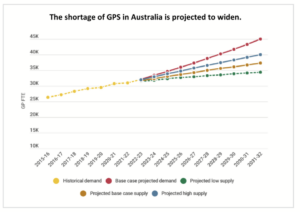
Stockhead: Bailador invests $20 million in digital healthcare platform Updoc
- Bailador invests $20 million in telehealth platform Updoc
- Investment is fourth in digital healthcare sector for Bailador
- Bailador realised 61% return when InstantScripts sold to Wesfarmers
Special Report: Tech-centric capital fund Bailador Technology Investments is confident of continued success in the digital healthcare space with a $20m investment in Updoc connecting consumers who need medical services with registered health practitioners via a telehealth platform.
The investment in Updoc is the fourth in the digital healthcare sector for Bailador Technology Investments (ASX:BTI), which continues to grow since the Covid-19 pandemic.
BTI saw a particularly successful investment with InstantScripts with the business scaling rapidly and being sold to Wesfarmers (ASX:WES) in 2023, generating a 61% IRR for BTI.
Co-founder and managing partner Paul Wilson says the company is continuing its successful involvement in the digital healthcare space with investments in Access Telehealth and Mosh, which are also scaling rapidly, driven by very strong patient demand.
Wilson says digital healthcare was thrust into the spotlight during Covid-19 lockdowns with the experience a revelation to many people that certain elements of healthcare could be delivered effectively, and in fact more efficiently, by using digital technology.
“A number of businesses are developing which allow patients to more efficiently address some routine health matters, while maintaining in-person general practitioner (GP) consultations as central to the healthcare ecosystem,” he says.
“This is benefitting patients, doctors, and the health care system itself.
Benefiting patients
Wilson says many patients are finding significant benefit in the convenience and efficiency of telehealth, including:
- Shorter wait times to get an appointment
- Eliminating travel time to and from a clinic
- Less time in clinic waiting rooms
- Less exposure to other sick patients
- More connected access to referrals and follow-ups
“Patients have wholeheartedly embraced digital healthcare, because it works for them. It is not just a question of convenience, but critical access to medical attention, particularly for many people living in regional communities, or requiring after hours care,” he says.
Wilson says telehealth is continuing to grow with around one-third of people having a telehealth consultation in 2021-22 with more than 80% occurring with a GP.
He says telehealth has become widely adopted across Australia and become a permanent integration into the health system.
Benefiting healthcare system
Wilson says a major issue facing the Australian healthcare system is a shortage of GPs.
“Demand for medical services has been growing at a rate faster than the availability of GPs, and this is projected to get worse, putting strain on the medical system,” he says.

Source: The Australian Medical Association. The General Practitioner Workforce: Why Neglect Must End, November 2022.
Wilson says while one way to address the shortage of GPs is to train and recruit more GPs, this is a lengthy process, and can’t keep up with the rate of demand and the backlog of growing health issues being experienced by the public.
“In the meantime, another more immediate part of the solution is to help GP consultations to be more efficient,” he says.
Wilson says there are several matters which might not always require a full standard 15-minute face-to-face consult, such as basic script renewal, medical certificates, or referrals to specialists, imaging, or for blood tests.
“Often these 15 minutes can include superfluous administrative time and history taking that can be captured through an optimised technological platform and shared in advance with practitioners,” he says “Telehealth consultations by registered practitioners can be an appropriate method to allow these types of consults to be performed more efficiently, thus facilitating more consultations overall and helping to address the GP shortage.”
He says this can allow additional time for in-person GP clinics to focus on more complex consultations.
Telehealth also means that there are less people carrying contagious viruses such as influenza into public areas to see a GP.
Not the whole solution
Wilson says telehealth is not intended to be utilised for every type of medical situation.
“In-person consultations with GPs will remain the gold standard at the centre of the health system,” he says.
He says telehealth consultations also enable doctors’ flexibility in the hours that they work, and their location.
“Overwhelmingly doctors who consult by telehealth also consult in person at clinics,” he says.
“By re-allocating some of their time to telehealth consults, doctors benefit from greater flexibility with their schedule, improving the efficiency of their care, or to earn some additional income.”
Room for several participants
Wilson says several participants in digital health have emerged, often with differing focus and specialisations.
“Some facilitate GP access, some service aged care or regional areas, some offer access to specialists that patients would otherwise not have been able to physically get to,” he says.
“It is healthy to have multiple participants addressing the needs of patients who are rapidly adopting digital healthcare as one part of their overall healthcare.“
Wilson says it stood out as a strong investment option in the digital healthcare space for BTI.
He will join the board of Updoc, aiming to leverage its sector expertise to assist the team on their growth journey.
“We have been extremely impressed by the efficient business that the Updoc founders, Cliffe Hodgkinson and Dylan Coyne, have built so far,” he says.
“Updoc have certainly found a strong product market fit, as indicated by the business achieving the number one spot in the Rising Star Category of the Deloitte Australia 2023 Tech Fast 50 awards.”
